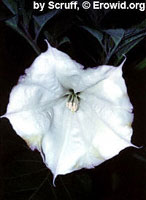Datura
Basics
DESCRIPTION #
Datura is a light green annual or biennial shrubby plant that grows from two to five feet tall (one to three meters). It has hairy leaves, spiny fruit, and vibrant flowers. The best known species are D. stramonium (Jimson Weed), D. metel, and D. inoxia. The plants, seeds, flowers, and roots have all been traditionally used for medicinal or visionary purposes around the world. Dried leaves have been made into smoking blends, sometimes with in combination with tobacco or cannabis, and all parts have been used to make teas and ointments. Because datura is plentiful in many parts of the world, it is sometimes ingested for its psychoactive effects by those who are unaware that its effects may be dangerous and are generally considered very unpleasant.
Datura seeds and flowers are usually more potent than the leaves and roots. Potency increases over the reproductive period and peaks while the plant is fruiting. As few as 10 datura seeds taken orally or one leaf brewed into a tea can produce profound perceptual changes, and 30-40 seeds is an extremely potent dose.
Price #
Live datura plants are both common as garden/yard plants as well as being available from most garden supply and ethnobotanical companies. Prices of live plants vary by species and vendor. Most datura consumed is from live plants rather than being purchased pre-prepared.
Datura is currently uncontrolled in the United States, though it has been outlawed for human consumption in a few states. Datura appears to be uncontrolled in most other countries as well.
The main active chemicals present in datura are the tropane alkaloids scopolamine, atropine, and hyoscyamine.
Pharmacology #
Scopolamine and atropine are anticholinergic deliriants. They block muscarinic receptors, which in turn excites dopaminergic neurons. They are readily absorbed, partially metabolized by the liver, and mostly eliminated in urine, with a half-life of about four hours.
Production #
Datura grows wild all over the world, and is commercially cultivated as a source of scopolamine. Many species are grown ornamentally.
Datura has a long history of medicinal and visionary use in India, Africa, Europe, and the Americas. Its use has been reported in medieval European witchcraft as a "flying ointment".
Terminology / Slang #
The Substance:
Datura; Jimson Weed; Devil's Apple; Thorn Apple; Stinkweed; Devil's Weed; Malpitte; Moonflower; Toloache (D. inoxia).
The Experience:
No common terms known.
The main effects of datura are delirium, extreme disorientation, and realistic hallucinations. Many users report periods of several hours in which they have no memory of what they were doing. Behavior is often irrational and accidental injury is a serious risk. Datura also causes physical effects including blurred vision/inability to focus the eyes (lasting up to several days), dryness of mouth, sedation or excitement, inhibited digestion, and an inability to perspire.
Onset #
When taken orally, the effects can begin in 20-30 minutes, but may take as long as 2-3 hours to be noticeable, depending on dose. When smoked, effects may begin in as quickly as 5 minutes.
Duration #
A moderate datura dose lasts 8-12 hours, while strong doses can cause effects lasting for 2-3 days.
Visual Effects #
Unlike the visual effects frequently reported with psychedelics such as LSD and psilocybin-containing mushrooms, datura causes frank hallucinations, meaning that the person cannot distinguish between the hallucinations and real objects. Elaborate visions and fantasies are common, sometimes including long conversations with imaginary persons. Smoking phantom cigarettes is often reported, even by non-smokers.
PROBLEMS #
PROBLEMS
The overwhelming majority of datura users describe their experience as very unpleasant and often physically dangerous. Users of datura commonly report blurred vision, sometimes lasting for several days. Datura may cause severe, long-lasting disorientation, confusion, delirium, and hallucinations. Accidents and self-injuries, sometimes requiring hospitalization, are alarmingly frequent among datura users. Several users of datura have reported committing crimes such as breaking and entering or assault while under the influence of datura. There are many reports of serious injury and arrest resulting from datura intoxication, and several deaths have been attributed to datura use. High doses of datura may be toxic.
Contraindications #
- Do not take datura without a sober sitter.
- Do not operate heavy machinery. Do not drive.
- Do not swim. Avoid bodies of water. At least one drowning has been blamed on datura use.
- Do not take datura in situations that may require you to be responsible for yourself or anyone else, or to be able to answer simple questions about who you are and what you are doing.
Addiction Potential #
Datura is not believed to be physically addicting nor likely to cause psychological dependence. Withdrawal effects following discontinuation have not been reported.
Long Term Health Problems #
Long Term Health Problems Summary Needed.
Risk of Death #
Datura alkaloids can have toxic effects, including coma or death. 4-5 g of dried Datura stramonium leaves can contain a lethal dose of alkaloids, while flowers and seeds are considerably more potent.
CAUTION & DISCLAIMER #
Erowid Basics pages are summaries of data gathered from site visitors, government documents, books, websites, and other resources. We do our best to keep this information correct and up-to-date, but the field is complex and constantly changing. Information should always be verified through multiple sources.



